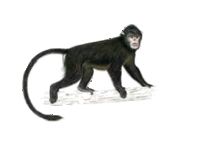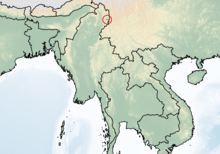Myanmar snub-nosed monkey
| Myanmar snub-nosed monkey | |
|---|---|

| |
| Scientific classification | |
| Domain: | Eukaryota |
| Kingdom: | Animalia |
| Phylum: | Chordata |
| Class: | Mammalia |
| Order: | Primates |
| Suborder: | Haplorhini |
| Infraorder: | Simiiformes |
| Family: | Cercopithecidae |
| Genus: | Rhinopithecus |
| Species: | R. strykeri
|
| Binomial name | |
| Rhinopithecus strykeri Geissmann et al., 2010
| |

| |
The Myanmar snub-nosed monkey
The species is known in local
Discovery and taxonomy
The Myanmar snub-nosed monkey was first discovered in 2010 from Gaoligong Mountains of northeastern Kachin state in Myanmar. The species came to the attention of a team of scientists allied to the "Myanmar Primate Conservation Program"
The
The team encountered seven live specimens, including an infant, but these moved out of sight before they could be photographed or studied in detail.
Physical characteristics
The monkey's fur is mostly black. Its crown consists of a thin, high, forward-curved crest of long, black hairs. It has protruding white ear tufts, a mostly naked face with pale pink skin, a "moustache" of whitish hairs above the upper lip, and a distinct white chin beard. The perineal area is white and clearly defined, and the limbs are mostly black; the inner sides of the upper arms and upper legs are blackish brown. The lips are prominent, and the nose upturned, allegedly causing the animal to sneeze in rainy weather.[14]
As in other snub-nosed monkeys (members of Rhinopithecus) there is distinct sexual dimorphism with males having relatively larger bodies.[3] Their tails are relatively long and normally approximately 1.4 times their body length. The first found specimen, an adult male, has a height of 55.5 centimetres (21.9 in), and a tail 78 cm (31 in) long.[15] From several specimens available, males on average measure 55.5 cm in height with 78 cm tail length, weighing 17 kg; while females are 53 cm tall with 64.5 cm tail length, and weighing 9 to 11.6 kg.[3]
Distribution and habitat
The species spend summer months in temperate mixed forests at upper elevations of their range, and descend to lower ground in the winter to escape snow.[16] In contrast to other snub-nosed monkeys which are mostly ground dwellers, the Myanmar snub-nosed monkeys are highly arboreal in habitat behaviour spending much of their times on trees.[3] Males are outnumbered females by 1 to 2.1.[17]
When first discovered, the only known specimens existed in three or four groups within a 270 square kilometres (100 sq mi) range at 1,700 to 3,200 metres (5,600–10,500 ft) above sea level in the eastern
On the morning of 16 October 2011, a forest guard at Gaoligongshan National Nature Reserve in China took photos of a group of snub-nosed monkeys which were later identified as R. strykeri. This made a breaking headline in China especially on the urgent need for a conservation programme.[6]
Habitat evaluation study shows that the Myanmar or black snub-nosed monkeys' habitat are covering 3670 km2 in Sino-Myanmar border, including core habitat of 1420 km2 .[20]
Feeding habit study shows this species can consume more than 170 plant species and fungal foods, 15 species of lichens.[21]
Conservation status
Origin and evolution
Snub-nosed monkeys and the
Recognition
See also
- Snub-nosed monkey
- Primates described in the 2000s
- List of endangered and protected species of China
Notes
- ^ . Retrieved 19 November 2021.
- ^ "Appendices | CITES". cites.org. Retrieved 2022-01-14.
- ^ S2CID 88764197.
- ^ S2CID 467234.
- PMID 36090144.
- ^ S2CID 205329996.
- ^ Wheeler Q (18 December 2011). "New to Nature No 61: Rhinopithecus strykeri". The Guardian. Guardian News and Media Limited. Retrieved 2013-05-26.
- ^ National GeographicRetrieved 28 Oct 2010
- ^ a b c "FFI discovers new species of snub-nosed monkey | News | Fauna & Flora International". Fauna-flora.org. Archived from the original on 2010-10-30. Retrieved 2010-10-28.
- ^ a b "New snub-nosed monkey from Northern Myanmar: Rhinopithecus strykeri". Primatology.net. 2010-10-27. Retrieved 2010-10-28.
- physorg.comRetrieved 28 Oct 2010
- ^ "Arcus Foundation | Push Boundaries. Make Change".
- ^ Catterick, Ally (10 January 2012). "First images of newly discovered primate: World's first look at the Myanmar snub-nosed monkey". Fauna & Flora International. Retrieved 11 January 2012.
- ^ a b Ella Davies (27 October 2010). "New species of snub-nosed monkey discovered in Myanmar". BBC. Retrieved 28 October 2010.: "The monkeys allegedly sneeze audibly when rainwater gets in their noses and local people said they could be found with their heads tucked between their knees on rainy days.".
- S2CID 467234.
- ^ 25 October 2010 Wiley - Blackwell. "New Snub-Nosed Monkey Discovered in Northern Myanmar". Alphagalileo.org. Retrieved 2010-10-28.
{{cite web}}: CS1 maint: numeric names: authors list (link) - ^ Guangsong, L. I.; Yixin, Chen; Wenmo, S. U. N.; Xinwen, Wang; Zhipang, Huang; Yanpeng, L. I.; Zuofu, Xiang; Wei, Ding; Wen, Xiao; Ming, L. I. (2014). "Preliminary observation of population status and social organization of Rhinopithecus strykeri in Pianma Town,Nujiang County,China". Acta Theriologica Sinica. 34 (4): 323.
- ^ a b ScienceDaily (July 26, 2012). First Photo Evidence of Snub-Nosed Monkey Species in China. Retrieved 15 September 2012.
- S2CID 467234.
- ISSN 0006-3207.
- S2CID 71145324.
- S2CID 467234.
- ^ "New hope for critically endangered Myanmar snub-nosed monkey". Deutsches Primatenzentrum (in German). Retrieved 2019-05-26.
- ^ Williams, Nathan (7 April 2020). "New protected area raises hopes for critically endangered monkey". Fauna and Flora International. Retrieved 12 July 2021.
- PMID 21435245.
- PMID 21436896.
- PMID 22616004.
- ^ Murray R (23 May 2012). "Top 10 New Species list includes sneezing monkey, blue tarantula and night-blooming orchid". Daily News. NYDailyNews.com. Retrieved 2013-05-26.

